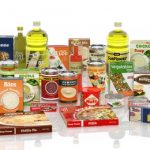Carbon dioxide production during food storage remains a safety and a quality issue. If a food or beverage in a glass container or other rigid package, should build up enough internal gas pressure then there is at least the problem visually of deformation and more dangerously, the possibility of explosion. Likewise, from a quality perspective, the generation of carbon dioxide gas is a measure of food deterioration and faulty packaging, perhaps as a result of unwanted fermentation.
A couple of useful reviews by Vermeiren et al., (1999, 2003) at Ghent University, Belgium outline the basic principles of the technology to scavenge this gas. It is now considered a part of active modified atmospheric packaging (active MAP). The physics and mechanisms of carbon dioxide absorption are very well reviewed by the Korean researcher, Dong Sun Lee and it is worth examining the detail in his articles if you want to know more about this type of active packaging (Lee, 2016). The stage we are at generally with this technology is a full understanding of CO2 production characteristics, the kinetic and thermodynamic properties of this gas and how it interacts with absorbers.
Some classic examples of study include vegetable fermentation in lightly processed food materials or during the roasting of fresh coffee beans as a result of Strecker degradation between amines and sugars (Labuza and Breene, 1989). A product that relies on carbon dioxide production as part of its process of manufacture is the formation of sauerkraut or kimchi whereby various vegetables are allowed to ferment. Neither product should be pasteurised otherwise the sensory qualities are spoilt.
Packaging must be designed to allow gas to leave or be mopped up otherwise visible signs of ballooning and bursting are possible. It is perhaps also desirable to exploit the antimicrobial activity of gaseous carbon dioxide in reducing surface growth of micro-organisms which implies much more careful control than is possible.
Absorbents In Use For Active carbon Dioxide Absorption
Carbon dioxide is best scavenged using calcium hydroxide contained in sachets which is combined with water, often released during fermentation forms calcium carbonate. Calcium hydroxide is cheap and relatively safe to use and is the absorbent of choice for many applications. It is also relatively inert but must be kept away from the main product. Other mineral adsorbents include sodium carbonate and magnesium hydroxide, and zeolites which are crystalline aluminosilicates. The zeolites have an interesting structure because they contain a framework of open channels and cavities which are ideal for absorbing gas within their void. These zeolites can be manufactured almost to order.
In the case of kimchi, loss of dissolved carbon dioxide leads to a reduction in the sensory quality of the product because carbonation provides a critical ‘bite’. Reversible absorption and adsorption using physical adsorbents such as zeolites and active carbon have also proved valuable (Lee et al., 2001).
Sachets are available with both oxygen and carbon dioxide scavenging properties.
Standa Industrie (France) provide both oxygen and carbon dioxide scavenging sachets in the ATCO range. These are sachets of coated paper with perforated polypropylene for access to gas and water vapour. These have been reported relatively recently (Charles et al., 2006). It is apparent that the combined and synergistic use of CO2 scavengers along with a range of other active packaging tools is helping to improve food quality through better preservation.
References
Charles, F., Sanchez, J., Gontard, N. (2006). Absorption kinetics of oxygen and carbon dioxide scavengers to design active modified atmosphere packaging. J Food Eng. 72(1) pp:1-7.
Labuza, T.P., Breene, W.M. (1989) Applications of “active packaging” for improvement of shelf-life and nutritional quality of fresh and extended shelf-life foods. J. Food Processing and Preservation, 13 , pp. 1–69
Lee, D.S. (2016) Carbon dioxide absorbers for food packaging applications. Trends Food Sci. Technol. 57, part A, pp. 146-155 https://doi.org/10.1016/j.tifs.2016.09.014
Lee, D. S., Shin, D. H., Lee, D. U., Kim, J. C., & Cheigh, H. S. (2001). The use of physical carbon dioxide absorbents to control pressure buildup and volume expansion of kimchi packages. J. Food Engineering, 48, pp. 183–188.
Vermeiren, L., Devlieghere, F., van Beest, M., de Kruijf, N., & Debevere, J. (1999). Developments in the active packaging of foods. Trends in Food Science & Technology, 10, pp. 77–86.
Vermeiren, L., Heirlings, L., Devlieghere, F., Debevere, (2003) Oxygen, ethylene and other scavengers. In: Novel Food Packaging Techniques. Edt. R. Ahvenainen. Woodhead Publ. Ltd. (CRC) pp. 22


I thought you needed carbon dioxide for preserving fruit and vegetables in packaging and you say it is useful to remove it. Please explain further as this article does not make sense really. Is it really only about the visual impact?